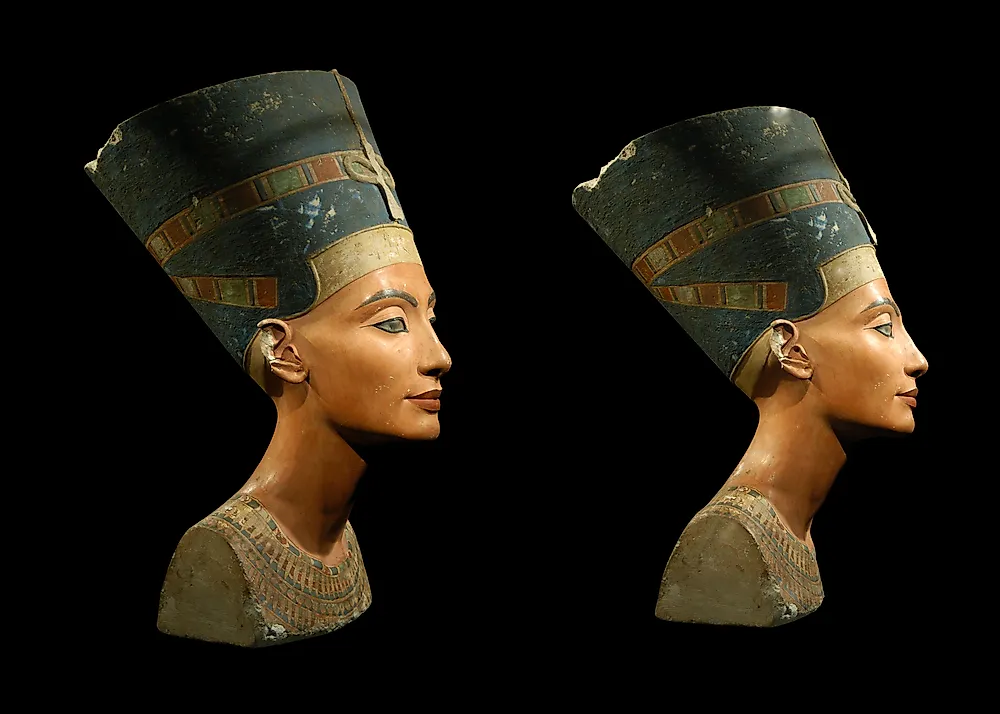Who Was the Famous Queen Nefertiti?

The mysterious and powerful Queen Nefertiti, whose name translates to “A Beautiful Woman Has Come,” is considered an iconic historical figure with a strong legacy.
An ancient Egyptian, Queen Nefertiti, who was also called Neferneferuaten-Nefertiti was the wife of King Akhenaten, previously known as Amenhotep IV, who reigned in Egypt from 1353-1336 B.C.E. Her participation in politics as well as administrative processes in Egypt at the time resulted in her being considered more powerful than any previous Egyptian queens. Today, she is widely known for her beauty, popularized through the representation of her bust. The disappearance of public records about Nefertiti as well as the fact that her body as well as burial tomb are yet to be found have raised several questions and theories about the last years of her life.
Early Life
Believed to have been born in circa 1370 BCE, Queen Nefertiti’s family background remains a point of contention. A widely accepted belief is that she was of Egyptian origin, and that she actually was the first cousin of her husband King Akhenaten, though there have been other beliefs regarding her origins. While some theorists believe that Nefertiti’s father was a top advisor named Ay, there are some who believe that she was originally from royal lineage from northern Syrian Mittani kingdom. As one can conclude, the mystery surrounding this beautiful and powerful Egyptian queen begins right from her origins, which remain disputed to this date.
However, most historians do tend to agree on the importance and relevance of Nefertiti’s involvement in ruling Egypt alongside her husband and Pharaoh Akhenaten, whose reign lasted from 1353 to 1336 B.C. During her reign over Egypt, she is credited, along with her husband to have transformed the kingdom.
There is general consensus that Nefertiti was a teenager when she was married to King Akhenaten. However, the precise date of their marriage as well as her eventual ascension to the status of the Queen of Egypt remain unknown. Nefertiti has been nicknamed as the "Ruler of the Nile" as well as the "Daughter of Gods", owing to the unprecedented power she is believed to have held as a queen in ancient Egypt.
Images of Nefertiti
Tracing Nefertiti’s appearance in history showcases that some of the earliest depictions of the Egyptian queen began in the context of her public appearance with her husband. The foremost images appear on the Theban tombs, of Parennefer, a royal butler and Ramose, an important vizier. In terms of the images themselves, Nefertiti is found riding a chariot with King Akhenaten, her husband, embracing him as well as sitting on his knee, which scholars believe to be a sign of the genuine nature of their relationship. Historians have also unearthed hieroglyphs, such as those found at Amarna, containing love poems written by King Akhenaten for Nefertiti. Nefertiti is often seen depicted as a mother and wife who is well loved by her family, who gave birth to six daughters.
Nefertiti’s images seem to appear more powerful in the King Theban temple called Hwt-Benben (“Mansion of the Benben Stone”) where she had privileges similar to the king as she appeared to serve in the role of a priest and make offerings to the Aton. A few more individual representations of Nefertiti reveal the power and beauty she has been associated with. For example, Nefertiti, appearing in her special tall blue crown, is seen in the smiting ritual against female enemies of Egypt on a set of blocks from Luxor and Al-Ashmunayn. Legend has it that Nefertiti improvised her own form of makeup with the use of the Galena plant. Queen Nefertiti was also noted as being proud of her long neck.
However, perhaps the most iconic image of Nefertiti, which we associate her with today, is that of a painted sandstone bust discovered around 1912, among the ruins of sculptor Thumtose’s workshop in Amarna. Housed today in the Altes Museum in Berlin, the bust is considered widely recognized and perhaps the most recreated and copied work of ancient Egypt. Nefertiti’s bust is iconic in modern times- even if you don’t immediately recognize the image as Nefertiti herself, Nefertiti’s bust is something that you’ve definitely seen- as lampshades, posters, on keychains and just about anything else. Historically as well, the bust is of great significance as Nefertiti somewhat remained lost in history until the German archaeological mission led by Ludwig Borchardt, who discovered the bust.
Other Legacies
Perhaps the most significant and recognized legacy Nefertiti has left behind from her co-ruling of Egypt, alongside Akhenaten, whose reign lasted around twelve years, is the shift in the religious landscape of Egypt. This also led to a transformed political and cultural landscape. Some of the significant events in this regard include Akhenaten’s decision to move the capital to the modern day Amarna during the fourth year of his reign. After a year, it is believed that Nefertiti, already highly noted for her beauty, added the title "Neferneferuaten" to her original name, leading to an updated meaning to her name- “Beautiful are the beauties of Aten, a Beautiful Woman has come.”
From the fourth or fifth year of Akhenaten’s rule, the cult of Amen was transformed to one of Aten. Aten, the sun god, became important as a national God, and Nefertiti played an important role in the new system. Evidence of her political influence and involvement have been especially found relating to this shift in the religious system and one can see depictions of her involved in ceremonies as well as proceedings. The king and queen were viewed as "a primeval first pair," and a vessel for relaying Aten’s blessings.
As the mystery around Nefertiti’s death remains, with her body yet to be found. While some claim she may have ruled the New Kingdom after her husband’s death, many believe her death occurred around the time of her husband’s death, lack of records around her after his 12-year reign have led. Historians are, to this debating she died in 1336 BCE, or perhaps 1334, with discrepancies over her burial location which may or may not be somewhere alongside her husband.











